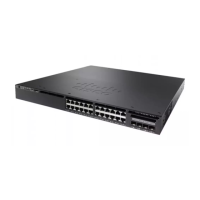Default SettingFeature
Version 2.PIM version
No mode is defined.PIM mode
None configured.PIM stub routing
None configured.PIM RP address
Disabled.PIM domain border
None.PIM multicast boundary
Disabled.Candidate BSRs
Disabled.Candidate RPs
0 kb/s.Shortest-path tree threshold rate
30 seconds.PIM router query message interval
How to Configure Basic IP Multicast Routing
Configuring Basic IP Multicast Routing
By default, multicast routing is disabled, and there is no default mode setting.
This procedure is required.
Before You Begin
You must configure the PIM version and the PIM mode. The switch populates its multicast routing table and
forwards multicast packets it receives from its directly connected LANs according to the mode setting.
In populating the multicast routing table, dense-mode interfaces are always added to the table. Sparse-mode
interfaces are added to the table only when periodic join messages are received from downstream devices or
when there is a directly connected member on the interface. When forwarding from a LAN, sparse-mode
operation occurs if there is an RP known for the group. If so, the packets are encapsulated and sent toward
the RP. When no RP is known, the packet is flooded in a dense-mode fashion. If the multicast traffic from a
specific source is sufficient, the receiver’s first-hop router might send join messages toward the source to build
a source-based distribution tree.
IP Multicast Routing Configuration Guide, Cisco IOS XE Release 3.6E (Catalyst 3850 Switches)
290 OL-32598-01
Configuring Basic IP Multicast Routing
How to Configure Basic IP Multicast Routing
